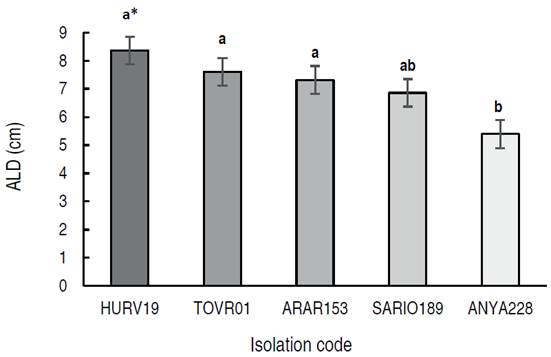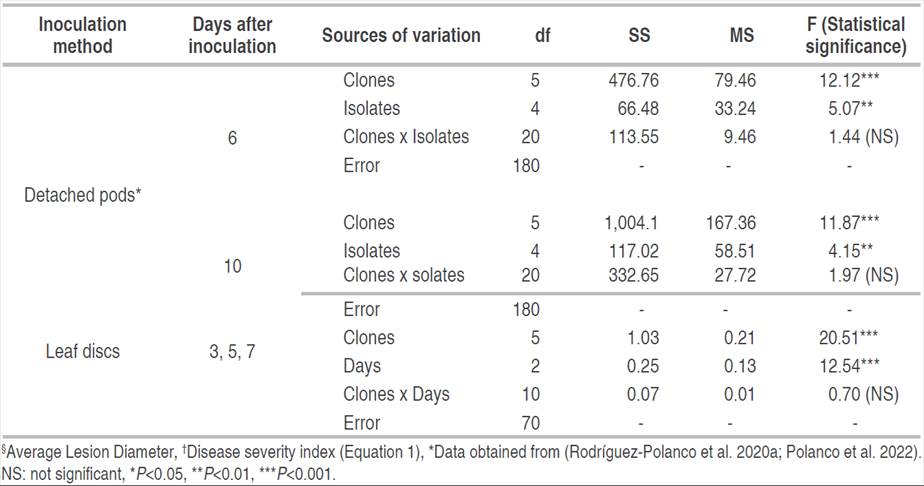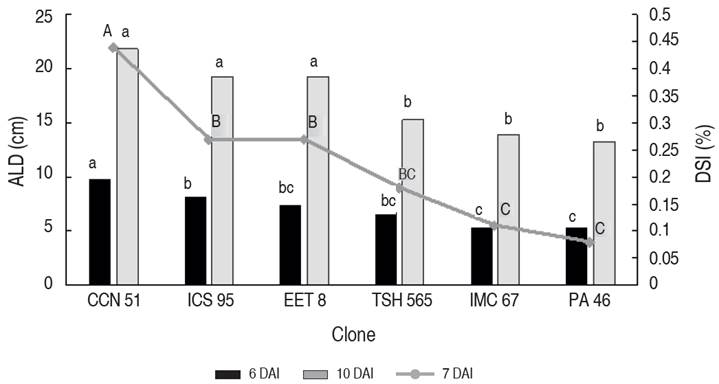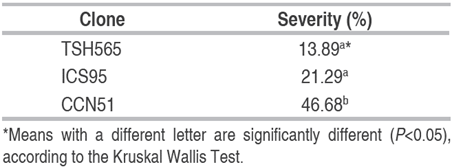Several Phytophthora species produce cacao black pod disease (BPD) or black pod rot, which occurs worldwide in most cacao crop areas (Ploetz 2016). It has been demonstrated that without any management, cacao losses could reach up to 50-100% due to BPD (Pokou et al. 2008), considered one of the most destructive cacao diseases registered globally. Phytophthora species with an economic impact on cacao production are: Phytophthora capsici Leonian, P. citrophthora (R.E.Sm. & E.H.Sm.) Leonian, P. megakarya (Brasier and Griffin 1979), and P. palmivora (E.J. Butler) (Surujdeo-Maharaj et al. 2016, Marelli et al. 2019). These species have been reported in the Americas and Cameroun (P. capsici), Brazil (P. citrophthora), and West Africa (P. megakarya) (Adeniyi 2019; Merga 2022). Phytophthora palmivora (Pp) is the sole exception, colonizing every region where cacao is cultivated (Brasier and Griffin 1979; Marelli et al. 2019). In addition to this, Pp is the most prevalent species in the producing areas in Colombia (Rodríguez-Polanco et al. 2020b; Palacios Bejarano et al. 2021).
BPD symptoms progression depends on the cacao genotype (clone), abiotic factors, and Phytophthora species (Martins et al. 2018; Puig et al. 2018; Pokou et al. 2019; Puig et al. 2021). Disease symptoms include black spots in pods, which spread rapidly and cause internal and superficial tissue damage, affecting cacao beans (Merga 2022). In the case of the northwestern region of Colombia, during the first 2 to 3 days after field infection, symptoms initiate as diminutive black spots and then spread as brown-black lesions (4 to 7 days), colonizing all the pod with white mycelia after 7 days (Rodríguez and Vera 2015). This disease progression was recorded in ICS clones caused by the Pp pathogen. Furthermore, the causal agent can also affect other cacao plant tissues (Surujdeo-Maharaj et al. 2016), producing resistant and long-term survival structures (Ko 2003), accelerating plant tissue decomposition (Guest 2007) and increasing the negative impacts on cacao production. Technical progress is struggling against BPD dissemination, including early detection (Franco et al. 2019; Yanac Montesino et al. 2021), crop management strategies (Rodríguez-Polanco et al. 2020c; Merga 2022; Misman et al. 2022), and plant genetic programs (Pokou et al. 2019; Fister et al. 2020; Tijani et al. 2020; Mucherino Muñoz et al. 2021; Rêgo et al. 2023).
Plant breeding represents a promising alternative against BPD, increasing productivity (de Souza et al. 2021) due to resistant cacao genotypes with interest traits (Pokou et al. 2008). Cacao genetic programs typically focus on developing cultivars resistant to plant diseases while achieving exceptional crop quality and productivity (Tahi et al. 2006). However, pre-breeding activities are essential to achieve the aims of these programs, such as screening pathogen aggressiveness in different plant materials. In the case of BPD, alternative methods have been employed to assess BPD in cacao clones, with in vitro inoculation and field evaluation as the most common approaches (Lessa et al. 2020; Tijani et al. 2020; de Souza et al. 2021). Consequently, experiments involving artificial inoculation have been conducted on various cacao plant parts to measure their resistance against Phytophthora spp. (Saul-Maora et al. 2007). In this sense, environmental control is attainable using artificial inoculation in the laboratory. The benefits of laboratory methods include confining pathogens, avoiding contamination, and occupying less space compared to a greenhouse (Miller-Butler et al. 2018). An additional benefit is that the accuracy of laboratory inoculation tests shows a positive correlation with the observed resistance rates in the field, as Nyassé (1997) demonstrated. Moreover, the positive correlations between laboratory inoculation and natural infection of immature and adult pods have been demonstrated (Pokou et al. 2008).
In the case of field screening tests, sometimes results are not feasible due to abiotic (environmental) or biotic (pests, other non-target diseases) conditions, affecting error-free estimations in disease behavior (Imathiu et al. 2014). Thus, techniques under standardized conditions, such as leaf discs and detached pods, represent a suitable alternative to increase time efficiency in cacao clone selection against BPD (Nyadanu et al. 2012). However, the association between these two laboratory techniques should be explored by employing Phytophthora isolates from Colombia. Accordingly, the aim of this study was to assess the resistance of Phytophthora palmivora by employing artificial inoculation in leaves and pods to establish the utility of the leaf test in early BPD resistance selection.
MATERIALS AND METHODS
Plant material
A total of six cacao clones were tested to evaluate their resistance to Pp isolates (Table 1). Within these, two control clones, the Phytophthora-resistant clone PA466 and the Phytophthora-susceptible clone CCN51 were included (Iwaro et al. 2003; Arciniegas 2005). These clones were obtained from the cacao germplasm bank of Agrosavia - La Suiza. The cacao clones chosen for this research represent the two primary cacao types commonly cultivated in Colombia, i.e., Forastero and Trinitarian (Motamayor et al. 2008).
Phytophthora palmivora isolates
A total of 60 isolates were obtained from the C.I. Nataima collection, where they are preserved in sterile distilled water in Eppendorf tubes at a temperature of 10 °C. The molecular identification of all isolates was previously assessed (Rodríguez-Polanco et al. 2020b).
The top five most aggressive Pp isolates were selected to exhibit the highest levels of aggressiveness in screening tests, previously performed based on the detached fruits methodology, according to Rodríguez-Polanco et al. (2020a). These isolates were sampled from distinct cacao production regions in Colombia, including Tolima (TOVR 01), Huila (HURV 19), Santander (SARIO 189), Antioquia (ANYA 228), and Arauca (ARAR 153). The isolates were reactivated using pods of clone IMC67 (not susceptible) to minimize any potential influence of the host clone on pathogen aggressiveness. The environmental conditions during the experiments were maintained at a relative humidity of 90% and a temperature of 28 °C.
All the isolates were cultured in Petri dishes containing agar-V8A juice (V8A) following the methodology described by Rodríguez-Polanco et al. (2020b) and incubated under darkness conditions at 25 °C for 12 days (de Souza et al. 2021). 10 colonies were inoculated in V8A per isolate to prepare the inoculum suspensions. The final concentration of the zoospores in the suspension was set at 3.0×105 zoospores mL-1.
Artificial inoculation of pods and leaves
Inoculation experiments of cacao pods and leaves were conducted in the Plant Pathology Laboratory at the Nataima Research Center of Agrosavia in the Municipality of Espinal, Colombia. The environmental conditions of the laboratory were maintained at an average temperature of 22 °C and relative humidity of 70%. In this trial, the Phytophthora palmivora isolate HURV19 was used for the artificial inoculation as it registered the highest level of aggressiveness in the previous experiment (Phytophthora palmivora isolates). In all experiments, clone PA46 was used as a non-susceptible control (R) and clone CCN51 as a susceptible control (S) (Iwaro et al. 2003).
Pod inoculation
The method for inoculating detached immature pods was conducted following the methodology described by Rodríguez-Polanco et al. (2020a). Two-month-old healthy cacao pods were initially covered with protective bags in the field. Once the pods were 4.5 months old, they were harvested and transported to the laboratory. Small filter paper discs with a diameter of 0.5 cm were prepared and soaked in Pp inoculum to carry out the inoculation. These filter paper discs were then placed at equal intervals in the equatorial zone of each cacao pod. Subsequently, the pods were individually incubated in a humid chamber at a temperature of 28 °C. The incidence of symptoms (absence/presence) and the severity of the infection, average lesion diameter (ALD), were determined by measuring the lesion from two perpendicular sides of the pod. The experiment was assessed at 6 and 10 days after inoculation (DAI) following the evaluation method outlined by (Arciniegas 2005). The ALD measurement was used to determine the infection response in each clone.
Leaf inoculation
Leaf inoculation was implemented following the methodology by de Souza et al. (2021). 10 healthy leaves were collected in the morning from slightly woody branches in the field. These were placed in polyethylene bags and transferred to the laboratory. Leaves were washed in tap water for 0.5 min, followed by a rinse with distilled water. Subsequently, a circular disc with a diameter of 1.5 cm was cut from each leaf using a cutter, obtaining 20 discs per cacao material.
The discs were placed in synthetic containers with the leaf underside facing upwards. Each container was equipped with a piece (3 cm) of sterile polyurethane sponge to create a high-humidity environment, providing optimum conditions for disease development. Subsequently, a zoospore suspension of 10 μL (3×105 zoospores mL-1) was inoculated on the middle of each disc using a micropipette. The containers were sealed and placed in a dark incubator at 25 °C for 7 days.
The leaf discs were assessed 3, 5, and 7 DAI, utilizing the Scale Degree according to Nyassé et al. (1995). The average values from the scale were then employed to calculate the disease severity index (DSI) of each clone, using the McKinney index equation (McKinney 1923) in Equation (1) as follows.
On farm contamination
BPD natural infection in the field was conducted in a commercial cacao farm in the Municipality of Palocabildo in Tolima, Colombia. The trial was established in a commercial cacao plantation located at 05°7'46.46"N and 74°59'59.9"S, and 1,235 masl. The area had adequate environmental conditions for the Pp infection, with lower temperatures at night (15 to 20 °C). These conditions favored pathogen reproduction by an increase of approximately 40% in the number of zoospores (Zentmyer 1980). Natural pod infections were assessed in 2015 for 12 months, i.e., two harvest periods. Due to the lack of cacao dissemination clones in the region, only clones CCN51, ICS565, and TSH565 were evaluated. 10 cacao trees per clone were selected randomly in the field. In each tree, all damaged pods affected by Phytophthora were assessed. Severity per tree was considered as the average of all pod evaluations. Pod severity evaluation was determined as the percentage of damaged area (cm2) considering the total pod area (cm2). Areas were determined by taking cacao pod photos and using the ImageJ program (Schneider et al. 2012). The assessment was conducted every 15 days for 12 months.
Pod inoculation
Two independent experiments were carried out in a completely randomized design with six cacao clones and five major aggressive Pp isolates, according to the methods stated by Rodríguez-Polanco et al. (2020a). The average lesion diameter (ALD) was evaluated (n=10). After confirming the homogeneity of variance (Cochran's test), the average data length (ADL) from both experiments was combined using Cochran's test (Gomez and Gomez 1984). The clone and the isolate were considered factors in a two-way variance analysis using ALD data. Means were compared by the t-test (P≤0.05). Statistical analyses were performed using the R program (R Core Team 2022).
Leaf inoculation and methods correlation
The experimental design and statistical analysis were carried out similarly to the ones used in the detached immature pod inoculation, except for using 20 repetitions per treatment. The inoculation method for detached immature pods was correlated with the inoculation method on leaf discs using Pearson's correlation. Statistical analyses were performed using the R program (R Core Team 2022).
Natural infection in the field
Natural tree infection was measured as severity in the field. Non-parametric analysis was conducted using Kruskal Wallis' analysis, with 10 repetitions (n=10). Severity was introduced as a variable and clones as a class variable. Pair-wise comparisons were carried out using (P<0.05). Statistical analyses were performed using the R program (R Core Team 2022).
RESULTS AND DISCUSSION
The aggressiveness of P. palmivora isolates
The average lesion diameter test inoculation in the detached pod test was assessed to test the inoculation effect of five Pp isolates (Figure 1), recording significant differences (P≤0.001). Isolate HURV19 (8.36 cm) showed the highest isolation value, and ANYA228 (2.03 cm) exhibited the lowest.

Figure 1 Aggressiveness of five Phytophthora palmivora isolates using the detached pod inoculation method 6 DAI (Days after inoculation). ALD: Average Lesion Diameter. *Letters above bar errors indicate statistical significance (P<0.05) according to Tukey's test.
An efficient and reliable screening method must evaluate plant material with the most aggressive isolate to prevent false negative results. In addition, it has been demonstrated that different Pp isolates establish variations in BPD symptom response (Barreto et al. 2018). In the current study, isolate HURV19 (8.36 cm) displayed the highest ALD value, demonstrating its aggressiveness potential. In Colombia, several studies have characterized Phytophthora species associated with BPD (Villamizar-Gallardo et al. 2019; Rodríguez-Polanco et al. 2020a; Ramírez Martínez et al. 2021), demonstrating the importance of testing Pp aggressiveness from different cultivated areas in the country. Although Pp species aggressiveness in cacao is known, no population study has been conducted in Colombia, with isolates of this species obtained from different productive regions. Thus, it is crucial to consider the knowledge of the existing variability between the isolates of this pathogen for its use in cacao genetic breeding programs against BPD.
Data analysis of artificial inoculation methods
The artificial inoculation methods, detached cacao pods and leaf discs were tested to evaluate the resistance level status against BPD in six different cacao clones under controlled environmental conditions (Table 2). The plant tissues assessed showed symptoms in all genotypes (clones). Regarding detached pods for the 2 days evaluated (6 and 10), statistical differences (P≤0.01) were obtained in clones and Pp isolates. Nonetheless, no significance between the interaction of these factors was obtained. Similar results were found in leaf discs. Statistical differences (P≤0.0001) in the factors host genotype x DAI (3, 5, and 7) were registered. However, the interaction significance between these two factors was not displayed (Table 2).
Table 2 Aggressiveness of Phytophthora palmivora inoculation in detached pods and leaves using ALD§ and DSI†, respectively, in six cacao clones.

This is one of the first research where six different clones were assessed with two inoculation methods under controlled conditions using Colombian Pp isolates. Inoculation success in all the clones demonstrates that isolate HURV19 can infect different cacao clones in Colombia. According to the results and considering the inoculation period, 6 days for detached pods and 7 days for leaf discs, both periods were sufficient to evaluate BPD under controlled conditions. Similar results were previously reported (Arciniegas 2005). In addition to this, high genetic resistance variation observed in cacao fields may reflect difficulties in the case of researchers interested in employing screening tests in this environment. On the contrary, time and space efficiency in implementing laboratory inoculation shows prompt resistance evaluation levels in cacao clones. Additionally, artificial inoculation methodologies demonstrate the possibility of potentiating possible resistance gene accumulation in field plant material (Mucherino Muñoz et al. 2021).
Linear Pearson's correlation indicated a significant connection with a moderate value (r=0.52) between lesion area in detached pods and leaf disc infection (P<0.0001). The manifestation period of BPD symptoms on leaves or pods varies based on the cacao clone and the specific Phytophthora species implicated (Barreto et al. 2018). The direct association between laboratory inoculation methods might be due to common genes expression involved in each genotype response for distinct plant organs. However, further research must be conducted in transcriptome analysis evaluating different cacao plant organs during the early Pp infection. The non-significant isolate and host interaction has been reported from the findings by Nyadanu et al. (2012), who established the non-specificity of Phytophthora species with cacao genotypes. This indicates that the resistance of cacao genotypes to P. palmivora could be applicable to other Phytophthora species that cause BPD in cacao in other cacao-producing areas worldwide.
Considering the positive correlation between the two artificial methods and the 1-day difference in symptom evidence, the leaf inoculation method is recommended as the preferred methodology for tolerance screening of BPD in cacao clones in the country. By utilizing foliage instead of pods for disease evaluation, a higher number of cacao clones can be screened due to the practicality of space in the laboratory. Additionally, this approach offers the advantage of year-round availability of photosynthetic tissue, unlike the limited availability of pods due to seasonal harvests. Previous studies have demonstrated optimal results in using leave inoculation for BPD assessment in cacao clones (Nyadanu et al. 2010; Lessa et al. 2020; Tijani et al. 2020; de Souza et al. 2021).
Cacao clone tolerance against BPD results demonstrate differences between the cultivars using the two laboratory-based methods (Figure 2). The trend between detached pods and leaf discs is clear for the six clones evaluated. Statistical differences explain the susceptibility of CCN51 against the disease, with 9.83 cm (6 DAI), and 21.86 cm (10 DAI). Conversely, PA46 showed the lowest lesion tissue against BPD, with 5.27 cm (6 DAI) and, 13.25 cm (10 DAI). Cacao clones IMC 67 and PA46 did not display statistical differences in all the cases.

Figure 2 Aggressiveness of Phytophthora palmivora inoculation in detached pods and leaves. Statistical comparison between ALD§ (detached pods) and DDI† (leaf discs) in six cacao clones. §Average Lesion Diameter. †Disease severity index (Equation 1). HURV19 was accepted as the Pp isolate. DAI: days after inoculation. *Means with different letters are significantly different (P<0.05) according to Tukey's test, Lowercase: ALD (Pod) analysis. Uppercase: DI (leaf) analysis.
Overall, resistant (PA46) and susceptible (CCN51) clone controls behaved as expected in both assays. At this point, it was demonstrated that the tolerance against BPD is associated with Amazonian forastero genotypes, which, at the same time, are amelonado or melon-shaped pods (Rodríguez-Polanco et al. 2020a; de Souza et al. 2021). In contrast, trinitarian materials have been represented as susceptible to BPD disease, as suggest Paulin et al. (2008). In this sense, the current study demonstrated that genotype CCN51 behaves as susceptible, consistent with other studies (Ramírez 2016; Delgadillo-Durán et al. 2020; de Souza et al. 2021). For this reason, the CCN51 clone might be employed as a susceptible control in BPD research in Colombia. The variations observed in disease progression among the evaluated cultivars in this research imply the presence of quantitative resistance, following the findings from a previous study conducted by (Legavre et al. 2015).
Field experiment
In the natural inoculation in the field assessment, statistical differences were observed in the clones available in the zone, i.e., TSH565, ICS95, and CCN51. Disease severity was taken as a variable in this case (Table 3). Once again, the CCN51 clone demonstrated susceptibility to the disease due to the highest tissue damage (46.68%) compared with clones THS565 and ICS95 (13.89 and 21.29%, respectively).
Table 3 Natural infection in cacao pods in the field employing lesion area (%) in three different cacao clones in a commercial farm in Palocabildo, Tolima, Colombia.

Data shown in the current study demonstrates the high reproducibility and reliability of laboratory methods in BPD cacao resistance, being leaf infection the methodology recommended. Other studies demonstrate the positive correlation between laboratory-based methods and natural infection in cacao crops (Efombagn et al. 2011; de Souza et al. 2021). It is well known that natural field infection requires a considerable period, particularly regarding cacao pod harvest taking place twice per year. Consequently, laboratory methods boost plant breeding programs, detecting resistant and susceptible materials in less time.
In the study conducted by Pokou et al. (2008), a notable association between the response of clonal cacao to natural infection of P. palmivora in field conditions and leaf disc inoculation, as well as in the inoculation of detached pods were identified. Additionally, their investigations revealed a particularly strong correlation coefficient between the inoculation of detached pods and field infection, consistent with the experiments described in the current study. A robust correlation was established between environmental control tests conducted on detached cacao pods and in vivo in the field, according to de Souza et al. (2021). The study highlights that these tests can be an initial screening method for evaluating germplasm. Additionally, gathering data in the field requires an adequate amount of time and favorable environmental conditions for pathogen growth.
This study represents pioneer research in Colombia by evaluating two artificial inoculation methods in various cacao clones with Phytophthora palmivora isolates from different cacao-producing regions in the country. The consistent success of leaf inoculation across all clones unequivocally demonstrates the effective control of environmental factors and the efficient use of space and plant tissue availability. Thus, a robust approach for screening BPD tolerance in cacao genotypes can be established, in agreement with Lessa et al. (2020). These findings contribute further to crop protection, guiding breeders in selecting tolerant cacao materials and researchers in developing integrated management strategies to combat Phytophthora palmivora, promoting the sustainability and productivity of cacao cultivation in the country.
CONCLUSIONS
A suitable methodology for Phytophthora palmivora isolates assessment in cacao clones under laboratory conditions, and its relationship under natural infection was established. All assessed clones exhibited Phytophthora palmivora incidence. However, the disease level was displayed distinctly in each material. The tolerance of cacao material PA46 and the susceptibility of CCN51 were validated, consolidating their respective classification. Moreover, the correlation between the two artificial inoculation laboratory methods indicates that leaf inoculation is sufficient to evaluate the aggressiveness of Phytophthora palmivora isolates. Further, natural field inoculation suggests a direct association between the laboratory and this in vivo methodology, demonstrating the possibility of selecting genotypes with the leaf disc method. This research proposes using this rapid BPD information status methodology in cacao clone materials that help boost pre-breeding programs that seek resistance against Phytophthora palmivora in Colombia.

















